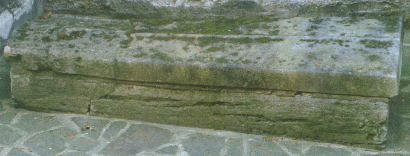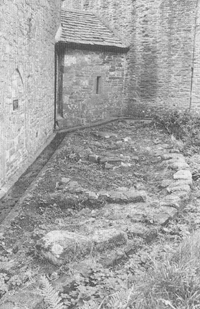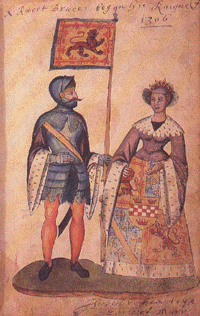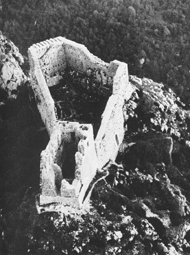 |
[ Outlaw Genealogy | Bruce
History | Lost Chords ] [ Projects | News | FAQ | Suggestions | Search | HotLinks | Resources | Ufo ] |
 |
[ Outlaw Genealogy | Bruce
History | Lost Chords ] [ Projects | News | FAQ | Suggestions | Search | HotLinks | Resources | Ufo ] |
 Templar Grave, Temple Church, London
Templar Grave, Temple Church, London
Due to the secrets that the Templars kept during their existence, and the incredibly
strange stories generated by their Inquisitors during their downfall, a large number of
myths have developed around the Templars. Some of these may be true. Some may not. It's
largely up to the individual to decide.
Devil Worshiping Knights
Temple of Eastern Knowledge
King Makers
Guardians of The Most Holy Grail
North America, Oak Island and the Templars
Home
The idea that the Knights Templar were devil worshippers arose out of tortures of the Inquisition. In order for Philip the Fair to confiscate the Templar holdings, they must be found guilty of heresy. So, using techniques later perfected during the witch trials that peaked around 1600, the Knights were tortured until they signed confessions. The fact that so many of the recanted (withdrew their confessions) as soon as the torture stopped was not a sign of innocence. The prevailing sense of the time was that people told the truth while being tortured. The thought that people would tell you whatever you wanted them to just didn't make sense at the time. The Templar treasurer was quoted as saying, "Under such torture, I would have confessed to killing God."
Under such torture, the Templars confessed to all sorts of crimes. At their initiations they, supposedly spat and walked on the cross, denied that Christ was the son of God, and promised to relieve all sexual desires with their Brothers. They were supposed to exchange lewd kisses on the lower back or navel (kissing on the mouth was actually an approved exchange between men at the time). They also confessed to idol worship. Several, though not many, of the confessions mentioned a head, made of metal or wood, that was sometimes referred to as Baphomet (see Temple of Easter Knowledge for a further discussion of Baphomet).
Ultimately, although a large number of Templars were burned at the stake as heretics, the charges against the Order as a whole, fell through. Ultimately the Pope dissolved the order with the excuse that the accusations alone would prevent people from joining it. It had therefore outlived its usefulness. To make sure that this attitude stuck, the Pope went on to say that anyone joining the Order in the future would be excommunicated and labeled a heretic. Aside from the confessions, again, most of them recanted after the torture, there was very little evidence that the Templars deviated from the basic Catholocism of the time. One theory is that during their initiation, they did recreate Peter's renunciation of Christ as part of the ritual. It was this that became the basis for some of the charges against them. Baphomet was never found.
 Since
the Templars were originally established in the Temple of Solomon, some of the status and
history of that location rubbed off onto the Templars. Also, since the Middle East in
general, and the Holy Land in particular, were a conduit through which poured the wealth
of knowledge of the Far East, surely, some of it came through the hands of the Templars.
Most of the ideas around this special knowledge of the East that the Templars hold are
suppositions based on slender facts. However, a few fun bits of knowledge do come out.
Since
the Templars were originally established in the Temple of Solomon, some of the status and
history of that location rubbed off onto the Templars. Also, since the Middle East in
general, and the Holy Land in particular, were a conduit through which poured the wealth
of knowledge of the Far East, surely, some of it came through the hands of the Templars.
Most of the ideas around this special knowledge of the East that the Templars hold are
suppositions based on slender facts. However, a few fun bits of knowledge do come out.
The Templars designed a number of their churches on the circular layout of the Temple itself (see the ruins at left, or Temple Church, London on the first page). It's this 'sublime architecture' that finds its way into the mythology of the Freemasons, a group claiming descent from the Knights Templar (see the King Makers section for more). The round churches were supposed to be an outward evidence of the wisdom brought back from the East.
The infamouse Baphomet that the Templars supposedly worshipped has another side to it. Apparently a very common medieval French spelling of the prophet Muhammad was 'Baphomet'. Thus, we can see that the Templars became the very thing they were fighting against, followers of Islam. Couple this with the agreements made during the war between the Templars and Saladin, or the Templars and Assassins (the kinds of agreements made between armies and warring powers the world over, not to be misconstrued) and you suddenly have a conduit for the knowledge of the East. At the time of their final persecution, some Templars in small enclaves in Spain and Egypt, sought refuge and converted to Islam.
 When
Philip IV and Pope Clement arranged to have the Templars arrested in France, they also
attempted to make the same arrangements in other countries. Edward II in England arrested
some the highest ranking members of the Temple and even allowed some of them to be
tortured (none of them confessed to anything). Germany and Spain merely converted their
members into other orders and thereby slid past the Pope. In Scotland however, Robert
Bruce was waging a war of independence against Edward. Bruce was already excommunicate and
he needed soldiers and funds. Bruce flagrantly and deliberatly ignored the Pope and sent
out word that all Templars would be welcome.
When
Philip IV and Pope Clement arranged to have the Templars arrested in France, they also
attempted to make the same arrangements in other countries. Edward II in England arrested
some the highest ranking members of the Temple and even allowed some of them to be
tortured (none of them confessed to anything). Germany and Spain merely converted their
members into other orders and thereby slid past the Pope. In Scotland however, Robert
Bruce was waging a war of independence against Edward. Bruce was already excommunicate and
he needed soldiers and funds. Bruce flagrantly and deliberatly ignored the Pope and sent
out word that all Templars would be welcome.
Meanwhile, in France, not all Templars were arrested. The Templar fleet set sail never to be heard from again. Supposedly, the 'Templar Treasure', the principal collection of cash, was not captured by Philip IV, but may have been smuggled to the fleet. Could the fleet have taken refuge in Scotland?
Bruce had fought against Edward I and Edward II for years. Things were actually going his way, when in 1314 Edward II gathered a great host, numbering at least double Bruce's men as well as being composed of a great number of mounted knights, of which Bruce had only a handful. The two armies met at Bannockburn, a few miles from Sterling Castle. The Scots force was mostly composed of foot soldiers armed with pikes and bowmen. The battle raged all day, with the English having trouble breaking Bruce's squares. The English were still a fighting force, if a very frustrated one, when all of a sudden a 'fresh force' of troops came charging onto the field. The English then panicked and fled from the field. This is usually credited with a group of camp followers who grabbed makeshift weapons, made banners from sheets, and charged into the fray. It seems a little unlikely that the English army would be fooled into thinking this was a fresh force. Also, since the English had withstood Bruce's foot soldiers attacks earlier in the battle, why would another attack from the same cause panic. However, what if this 'fresh force' were a small contingent of Knights Templar, taking refuge with Robert Bruce? A group of the most highly trained and motivated knights in all of Christendom charging into a battle that was already going badly could have provided the panic that the English army suffered.
 Mt
Signeur Castle, the Grail Castle?
Mt
Signeur Castle, the Grail Castle?
Wolfram von Eschenback wrote his poem Parzifal in 1220. The knights who guard the Holy Grail, the Grail castle, and the Grail family are Templars. This was written when Templar fortunes, economic and spiritual, were at their height. Of course, Templars were just not around in the times of King Arthur (the period when the Grail legends take place). Eschenback, it is suggested, was attempting to tell us that the Grail (whatever it might be), was still with us, in the time that he was writing, and guarded by Templars.
I don't have the space to go fully into this here, but in books by Michaale Baigent, Richard Leigh and Henry Lincoln a byzantine plot arises. The Templar knights are at its center along with the Holy Grail. Or should we refer to it as Holy Graal, from sang raal, or the Holy Bloodline. That is to say the bloodline of Christ, which the Templars were assigned to protect. And this, not greed on Philip IV's part, brought about their downfall. Everything is revealed in the small village Rennes-Le-Chateau in France. Hidden in strange encryptions around the town is a secret. What that secret is composed of is the principal mystery. Suffice to say, this is the best of all the Templar myths and my own personal favorite. Read the books (see my Reference page for titles).
A slightly new myth has risen around the Templar Knights. This come from a couple of directions. The first (and most lucid) is based on Andrew Sinclair's book, "The Sword and the Grail". Basically, at the time of the persecution, Sinclair proposes that the last of the Templars fled with the treasure to Scotland (see the section Kingmakers). There they took part in the foundation of the St. Clair family (later changed to Sinclair). The Sinclair's built Rosslyn Chapel (mentioned and detailed in several sources as a possible link between the Temple and Freemasonry). This becomes, either temporarily or, is still, the resting place of the Holy Grail (see Guardians of the Grail) which is part of the Templar treasure. Then, along come a pair of Venician's, the brother's Zeno.
The Sinclairs, who have become by now the Grand Masters of the Order, want a new land to set up the perfect Templar government. So with the money and military might of the Templars and the navigational and sailing abilities of the Zeno's, they set out to the west. The evidence is mostly contained in the Zeno Narrative and a map attributed to Vopell and Vavassatore which shows Nova Scotia (New Scotland) with the figure of a crowned knight. This is also further supported by evidence of European visitors in New England. This includes the NewPort Tower in Newport, Rhode Island and, the Westford Knight (a carving of the figure of an armored, European knight, including a cruciform sword, a common Templar emblem on graves). For more details, read the book.
But, what became of the Treasure? Let's assume that after escaping from France with the treasure, buying lands in Scotland, supporting Robert the Bruce's successful bid for the kingdom, building and sustaining the St. Clair's and funding a less than successful expedition to the new world, there was actually still treasure remaining. Then, as the unsuccessful colony dies out, instead of sailing back east with the treasure, the American Templars decide to hide it. They build an incredibly complex "Money Pit" on Oak Island in Nova Scotia. They mark the spot using arcane symbolism involving rocks laid out in the form of a cross. This is the latest idea to explain both the final resting place of the Templar Treasure and where the Oak Island "Money Pit" came from. For more details check out Oak Island & The Templars. For more general details on Oak Island go to the Oak Island home page.